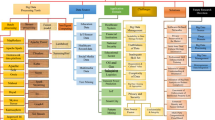Abstract
With the increasing integration of different technologies in a growing range of equipment and products, big data is a paradigm shift that involves data analysis, using well-known schemes, to extract patterns in hidden relationships. This is the radical change in the “business model” of a company related to the monetization of the data it collects. The biggest question for a company is no longer deciding if it should launch new products, but rather taking advantage of available (structured or unstructured) data and to know how to develop a high performance and design an appropriate mining to efficiently analyze big data and to find the useful things from it. The objective of this paper is to show that the challenges of the era of “data revolution” focus on data uses. It is linked to the rise of the intangible economy that mobilizes knowledge and highlights the importance of data. To deeply discuss this issue, this paper illustrates the buzz words related to data especially big data and open data, in order to illuminate the discussions of data valorization.

Similar content being viewed by others
Notes
The first use of the term Big Data was in 1999 in an academic paper—Visually Exploring Gigabyte Datasets in Realtime published by the Association for Computing Machinery.
In France, for example about 65 million people, 83 % are Internet users. Forty-two percent are on Facebook, 28 million members. More than 72 million phones are activated and the French spend on average of more than 4 h at their computer to surf the Internet every day. The French mobinautes spend 58 min and 68 % of the population is registered on social networks. The French pass over than 1 h 30 every day at the consultation of the social networks.
Describe the growing number of devices online and the potential for them to communicate with each other, often without a human “middle man.” The term is used as the title of a presentation given to Procter and Gamble by RFID pioneer Kevin Ashton.
TRIS laboratory: Treatment and Research of Information and Statistics.
Setting up R&D by e-prospects with TRIS researchers.
Lobby is an organized structure to represent and defend the interests of a particular group by exerting pressure or influence on people or institutions holding power… Examples include the work that the association UFC has made “What should I choose” that provided documents to parliamentarians to raise awareness of the health risks of obesity among middle school and high school students (see: http://www.lobbyiste.org/).
Examples include the work that the association UFC has made “What should I choose” that provided documents to parliamentarians to raise awareness of the health risks of obesity among middle school and high school students (see: http://www.lobbyiste.org/).
References
Ackoff, R. L. (1989). From data to wisdom. Journal of Applied Systems Analysis, 15, 3–9.
Bughin, J., CHUI, M. (2011). The rise of the networked enterprise: Web 2.0 finds its payday, McKinsey on Business Technology, vol. 22, Spring, disponible à l’adresse: http://www.mckinsey.com/insights/high_tech_telecoms_internet/the_rise_of_the_networked_enterprise_web_20_finds_its_payday. Consulté le 02 février 2014.
Eliot, T.S. (1934). The rock, Faber and Faber, disponible à l’adresse: http://www.wisdomportal.com/Technology/TSEliot-TheRock.html.
Martinet, B., & Marti, Y. M. (2001). l’intelligence économique: comment donner de la valeur concurentielle à l’information. Paris: Ed d’Organisation.
Matouk, J. (2014). La Revue de la MTRL mutuelle et santé, no 84.
Mayer-Schonberger, V., & Cukier, K. (2013). Big data: a revolution that will transform how we live, work and think.
McNulty, E. (2014). Big Data: the seven V’s, disponible sur: http://dataconomy.com/seven-vs-big-data/
Monino, J. L. (2005). Manager l’information. Les matins de la cité: CCI de Montpellier.
Monino, J. L., & Lucato, G. (2006). Manager l’information : comment faire aujourd’hui ? Les matins de la cité: CCI de Montpellier.
Monino L.L., Sedkaoui S., Matouk J. (2014). Big data, éthique des données, et entreprises, Les cahiers du CEDIMES, Dossier Economie et gouvernance, vol. 8, n° 2, disponible à l’adresse: http://cedimes.com/images/documents/cahiers_cedimes/cahier_cedimes_vol_8_N2_2014.pdf.
Pinte, J.P. (2006). La veille informationnelle en éducation pour répondre au défi de la société de la connaissance au XXIème siècle : Application à la conception d’une plateforme de veille et de partage de connaissance en éducation, http://hal.archives-ouvertes.fr/tel-00143990/.
Rotella, P. (2012). Is data the new oil?, disponible sur: http://www.forbes.com/sites/perryrotella/2012/04/02/is-data-the-new-oil/
Taylor, R.S. (1980). Value-added aspects of the information process, Communicating Information: Proceedings of the 43rd ASIS Annual Meeting. Anaheim, CA, vol. 17, 5–10 Octobre.
Author information
Authors and Affiliations
Corresponding author
Rights and permissions
About this article
Cite this article
Monino, JL. Data Value, Big Data Analytics, and Decision-Making. J Knowl Econ 12, 256–267 (2021). https://doi.org/10.1007/s13132-016-0396-2
Received:
Accepted:
Published:
Issue Date:
DOI: https://doi.org/10.1007/s13132-016-0396-2




